Minds On
The importance of clean water
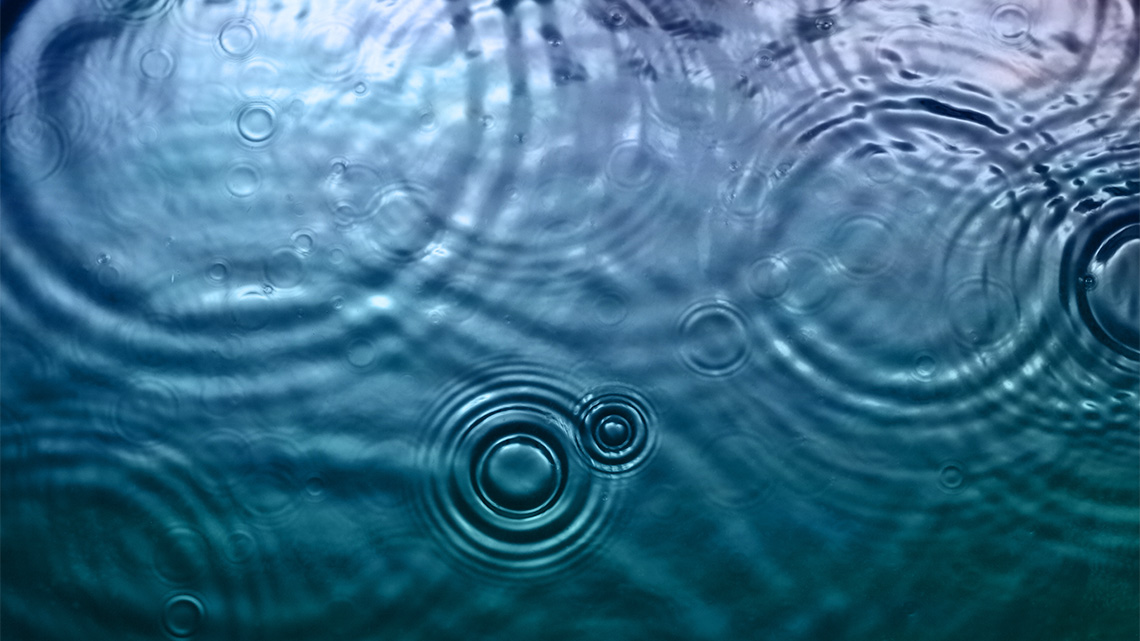
Clean water and sanitation as a human right. There are water disparities and unequal access to sanitation services around the world for different communities and persons. There exists violence and discrimination around access to washrooms and sanitary products, and clean water is an issue for many countries and communities for a variety of reasons. Lack of access to clean water and sanitation is an example of a human rights violation.
Brainstorm
Let’s brainstorm
What is the importance of clean water?
What is clean water used for and why do communities rely on clean water?
Record your ideas orally, digitally, in print, or in another method of your choice.
Action
Global connection
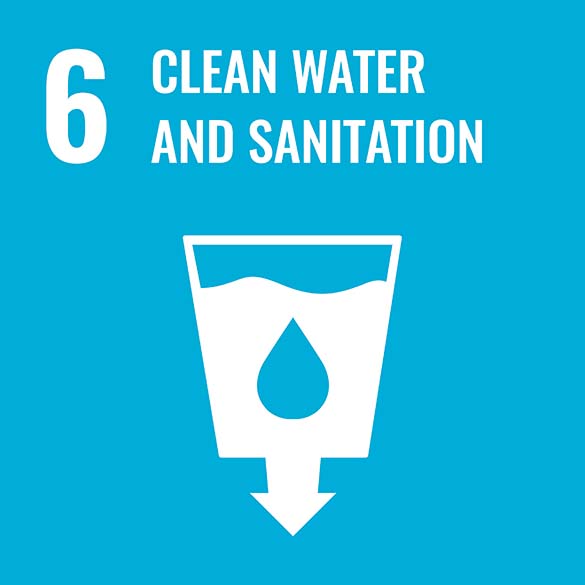
The United Nations (UN) is a group of many countries from around the world that have come together to create a better future for people and the environment. They have created 17 goals called the Sustainable Development Goals.
At the beginning of this module, you explored UN Goal 6 –Throughout this learning activity, you will be exploring how UN Goal 6 – providing clean water and sanitation to all people, worldwide, that is safe and affordable – is linked with UN Goal 5, which is aimed at reducing gender inequalities.
Press the following tabs to explore more about UN Goal #6.
Goal #6: Clean Water and Sanitation
According to United Nation Sustainable Development Goal 6, everyone in the world should have access to and sustainable management of water and sanitation. Access to safe water, sanitation, and hygiene is a human right and currently the demand for water is greater than can be sustained.
Water is essential not only to health, but also to reduce poverty, food security, human rights, ecosystems, and education. One of the most effective ways to prevent spreading disease is by washing our hands, however, in 2017 it is estimated almost 3 billion people in the world did not have such access.
Water scarcity affects more than 40% of the global population and is projected to rise. By managing water sustainability, there is a greater ability to manage food and energy production. By 2030, the United Nations has outlined targets such as providing global access to safe drinking water, improving water quality by reducing pollution, and increasing water use efficiency around the world.
Barriers to accessing clean water
In many communities, there are unique impediments to accessing clean water and sanitation. Inclement weather like droughts, shortcomings in governmental policy, or waterway contamination are all contributing factors to clean water scarcity and a lack of proper sanitation options.
Communities in Kenya and Tanzania
It is a traditional practice of certain communities around the world for the women, girls, and people with vaginas to be responsible for collecting the shared water supply. Communities in certain regions in Kenya and Tanzania, for example, lead this gendered water collection practice, and there is additional labour for the water carriers during seasonal drought when access to water becomes extremely limited.
Explore the following video about water collection practices by rural communities in a region spanning the border of Kenya and Tanzania that has been significantly affected by drought. Please note that this video clip contains the use of the phrase “developing countries”, which is no longer commonly used due to its lack of specificity and problematic, homogenizing implications around the “geographic distribution of poverty and prosperity” (Fernholz, 2016).
Fernholz, T. (2016, May 17). The World Bank is eliminating the term “developing country” from its data vocabulary. Qz.com. https://qz.com/685626/the-world-bank-is-eliminating-the-term-developing-country-from-its-data-vocabulary/
As you explore, record three ideas that you thought were very important from the clip. If possible, compare your ideas with someone else. Record your work in the method of your choice.
Press ‘Possible Answer’ to access explore some of the facts mentioned in the video clip.
Goal #6: Clean Water and Sanitation
- Women, girls and people with vaginas in regional communities like N’Gabolo are traditionally designated the role of collecting water.
- Water supplies are scarce and often contaminated because water is shared with animals.
- Up to two to three hours per day is spent gathering water.
- Time spent collecting water takes away time from other activities such as looking for work or going to school.
- Water was found 80-90 feet underground in a hole, and as it is used up, families have to move further to get water.
Did You Know?
Barriers beyond water
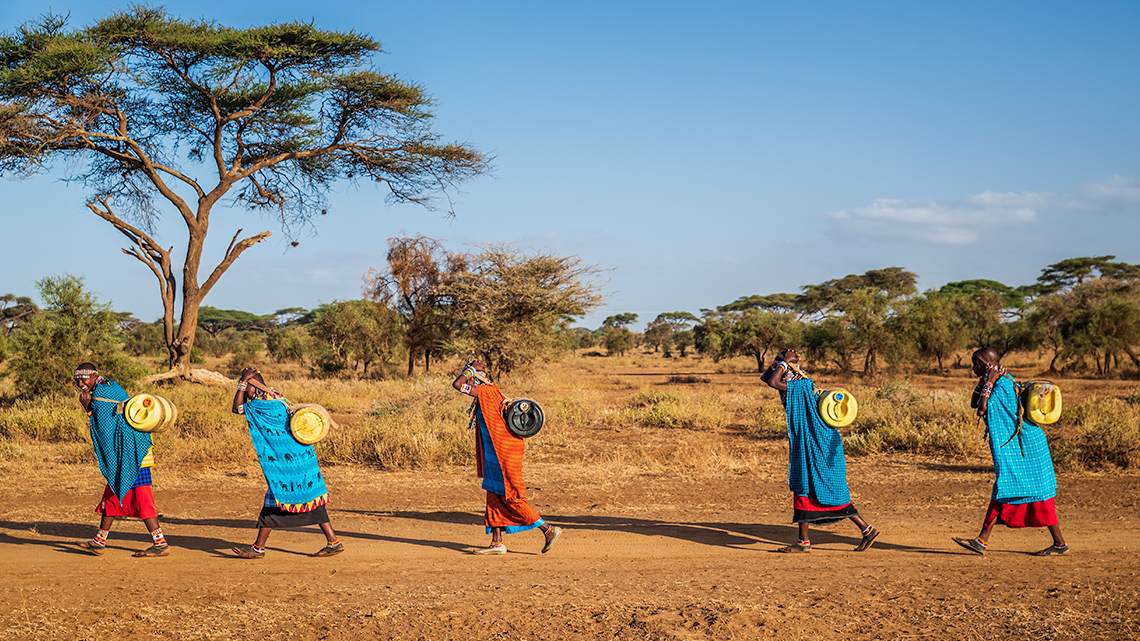
The responsibility of collecting water is often very time-consuming because of the absence of clean water sources, which is further impacted by the dryness of the season. Due to much how much time is spent on walking to collect water, this also impacts the ability of women, girls and people with vaginas to work and go to school. This inequality, therefore, contributes to a wider economic gap with men and masculine-identified people in the community.
Clean water scarcity: a global issue
While the communities in the video clip face significant water scarcity, it is important to note that there are various groups who lack access to clean water and sanitation all around the world, and it is not an issue exclusive to people in countries in the Global South.
There are many Indigenous communities in Canada that do not have access to safe, clean drinking water. Indigenous peoples have been advocating for change to ensure their communities have their basic human rights fulfilled. They have also started initiatives and partnerships to help continue their tradition of protecting the water for future generations.
The following five Indigenous initiatives are working toward Indigenous peoples’ right to protect and access clean drinking water:
Innovating for change
Innovative water technology
Now let’s explore some innovative ideas that are being developed around the world to provide access to safe water and sanitation.
Some examples of innovations have particular relevance to the women, girls and people with vaginas who are tasked with collecting water as explored in the video clip. These innovations will not only benefit women, girls, and people with vaginas by allowing them to focus more on working and school rather than collecting water each day, but it will also benefit every community member because access to clean water and sanitation supports our overall health.
As you are exploring, take note of the advantages and disadvantages of each technology in the graphic organizer provided or in another method of your choice. Access the following fillable and printable document Technology Advantages and Disadvantages to complete the activity.
Technology |
Advantages |
Disadvantages |
|---|---|---|
WaterSeer |
||
Flowered Project |
||
Hippo Roller |
Press the ‘Activity’ button to access Technology Advantages and Disadvantages.
Press the following tabs to access each water technology.
VICI Labs has invented the WaterSeer. A WaterSeer is a wind turbine, and a tube planted several metres into the Earth’s surface where it is surrounded by cool earth. It uses the surrounding environment to extract water from the atmosphere. Above ground, a small wind turbine spins which turns fan blades inside the device.
These fan blades send the air into a condensation chamber and as the warm air cools, it creates condensation that flows down to the lower chamber and can be extracted with a simple pump. In ideal conditions, it can collect 37 litres of water per day. However, in some areas, there is concern that this device is too fragile and would not withstand the environmental conditions.
A WaterSeer would be expensive to install for communities. A non-profit company is stepping up by providing one WaterSeer in an area in the world that lacks access to safe water for every one that is bought in the United States.
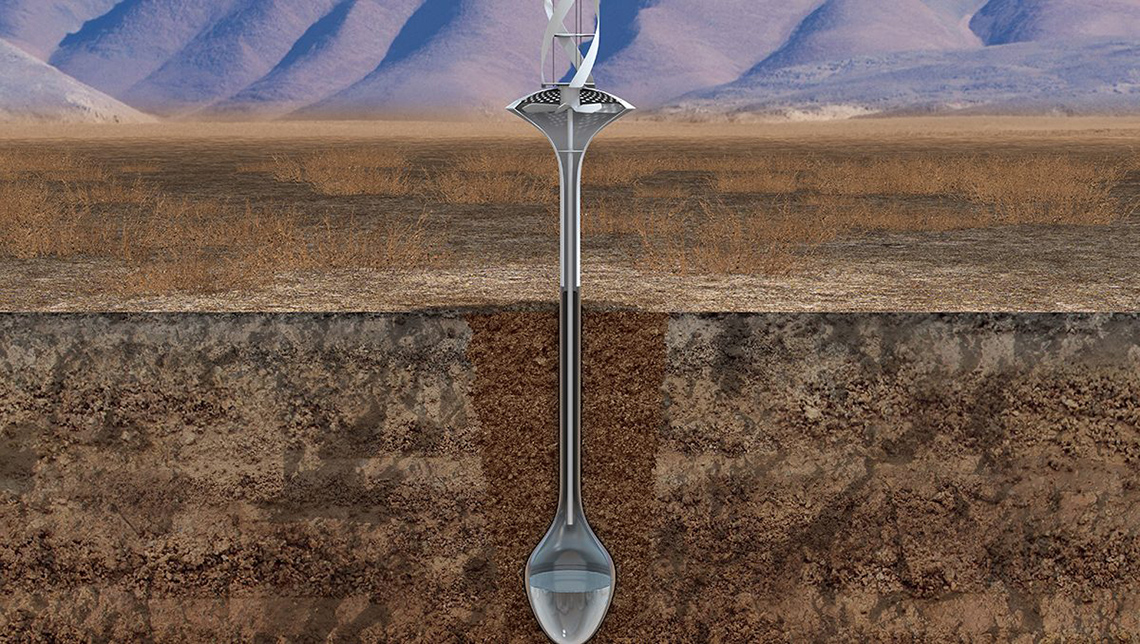
VICI Labs install their water condensation storage systems underground
The Flowered Project has developed a battery operated, portable device for decontaminating water. Groundwater is a main water source in many countries, but much of this water is contaminated with dangerous levels of fluoride making it unsafe to consume. The developed device has a 20-litre tank and recirculating pump that is powered by a car battery. The prototype was recently tested in Tanzania and showed a decrease in contamination within two hours and only cost around $250 to use. The project will hold in high regard gender equality because women will be involved directly in the training activities to use the device so that they can safeguard their family’s health.
African engineers have designed the Hippo Roller water wheelbarrow. It was developed in response to women and children carrying buckets of water that are extremely heavy on their backs and heads multiple times a day. The Hippo Roller can carry more than 90 litres of water and can be rolled rather than carried. This would mean fewer trips to collect water and more time for women and children to attend school or work. The durable wheel has a lifespan of five to seven years. The company who produces the Hippo Roller is insistent that communities be provided with access to safe water directly in their community, however, is attempting to provide something that can be used until this goal is achieved.
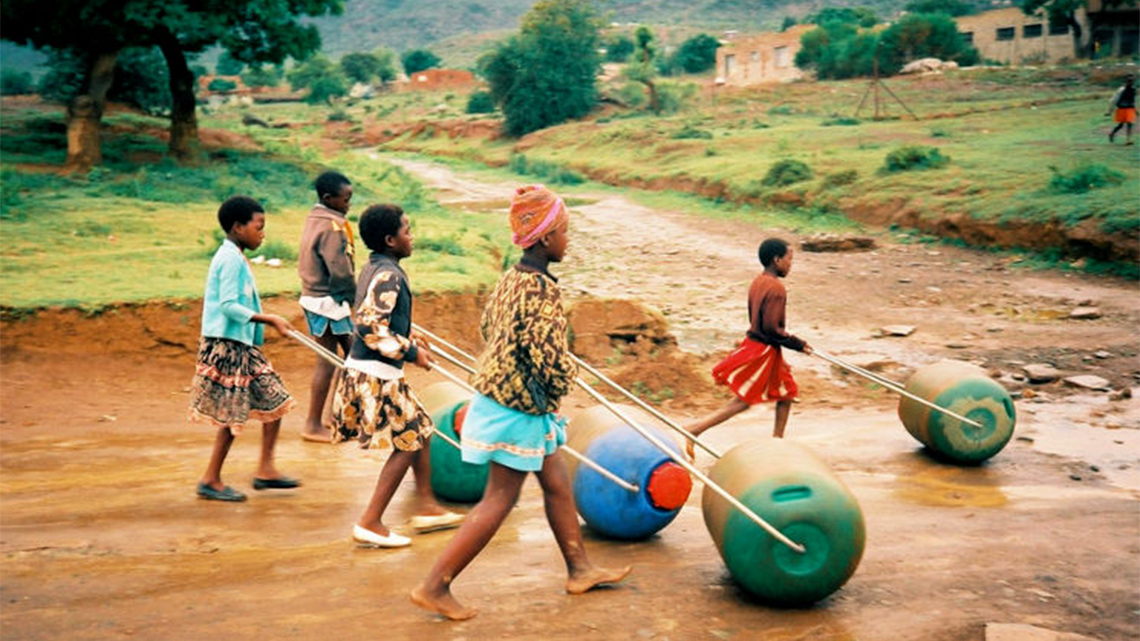
The Hippo Roller is a water collection solution.
Press ‘Hint’ to access the Answer Key.
Access the following fillable and printable document “Answer Key: Technology Advantages and Disadvantages” to examine the answers.
| Technology | Advantages | Disadvantages |
|---|---|---|
WaterSeer |
easy to operate turns moist air into water can be installed anywhere (near homes to provide easy access and avoid walking for water) |
reliant on wind expensive fragile |
Flowered Project |
involves women in training only needs a car battery and tank to operate decontaminates water portable |
does not give water, but decontaminates water if you have it need access to a car battery |
Hippo Roller |
cheap and simple to make durable and will last 5-7 years allows less trips to get water and less physical strain on back and neck |
not a solution to the lack of access to safe water still requires trips to obtain water may be difficult to operate on rough or hill terrain |
Press the ‘Activity’ button to access Answer Key: Technology Advantages and Disadvantages.
Consolidation
Research further and educate!

Throughout this learning activity you have explored UN Goals 6 and 5 and made connections to how gender equality is affected by access to safe and reliable drinking water and sanitation.
An important part of learning about global issues such as gender equality and access to safe water is to educate others about what you have learned.
Step 1: Research an innovation/initiative
Select an innovation to research further:
- Waterseer
- Flowered Project
- Hippo roller
- Another innovation or initiative of your choice
Before beginning your research, explore this video that explains the scientific research process to help guide you while you are completing the task.
Check out this video to learn about the steps of the Scientific Research Process.
After reviewing the video, explore the following interactive checklists to support your research process.
I can choose resources by
I can analyze and interpret findings by
Throughout your independent research, you may record information in any method of your choice. If you would like, you may complete your research notes using the following fillable and printable graphic organizer:
|
Innovation/initiative: |
Community this affects: |
When it was created: |
How it works: |
|
How has it contributed or will contribute to improving access to clean water: |
Press the ‘Activity’ button to access Independent research task: water innovation.
Step 2: Prepare your informative response
Choose one of the following options to educate others:
If possible, share your knowledge with others!
Reflection
As you read the following descriptions, select the one that best describes your current understanding of the learning in this activity. Press the corresponding button once you have made your choice.
I feel…
Now, expand on your ideas by recording your thoughts using a voice recorder, speech-to-text, or writing tool.
When you review your notes on this learning activity later, reflect on whether you would select a different description based on your further review of the material in this learning activity.